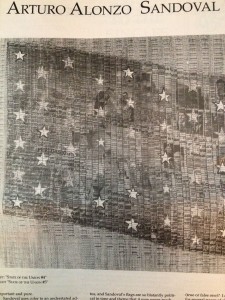Ace June 1991
The Woven Flags of Arturo Alonzo Sandoval
A Provocative Vision Achieved Through Political Conscience
by Louis Zoellar Bickett III
Arturo Alonzo Sandoval is a University of Kentucky professor of Art and an internationally reputed fiber artist who knows what censorship is. He has been a victim of it. His flag work, “State of the Union No. 10 – Lady Libe rty’s Bicentennial Celebration,” was shown in three cities in China before being censored in Beijing in 1989 because of the student riots in Tiananmen Square.
rty’s Bicentennial Celebration,” was shown in three cities in China before being censored in Beijing in 1989 because of the student riots in Tiananmen Square.
The fact that Sandoval is a man of color has been a driving force in his production of art with political themes and has helped to form his world view and has created his truth. His current imagery deals with terrorism, nuclear issues, and the apathy of a non-voting American population.
Sandoval has created 15 flags since 1984 (a significant piece of Orwellian symbolism in itself). The initial one, “State of the Union No. 1” was constructed from tobacco barn roofing material as a base, is woven with it and incorporates mink fur and metallic thread. It was inspired from a Cokie Roberts statement on NPR that she had noticed that there were more mink coats at the Reagan inaugural than at the the Carter one. That this and all of Sandoval’s work is either woven or incorporates a plaiting kind of technique, of the feeling of being woven, is a significant aspect of the technical properties of his oeuvre, because he is a weaver (like several generations of Sandovals before him) and a fiber artist, and though he clogs the grooves with the provocative nature of his work, he does fit nicely into the mechanism that makes up the fiber world.
The six flags on display at the Galbreath Gallery in downtown Lexington, Kentucky, offer an image and view that is not necessarily one of an orderly continual flow of one piece to the other — how they changed and grew, or didn’t grow, in the way they went from number one to number fifteen. Some do show radical changes from others, and since they were hung without the sequence of creation, the curator either thought it was not important or there existed not enough room, or both.
What the hanging does show is a vision from an artist of great moral concern and direction who feels passion for his cause. The passion and strength of it come through, of course, in some pieces more than others — as is the nature of any serious body of work.
The work, “State of the Union No. 10 – Lady Liberty’s Bicentennial Celebration,” contains silk satin fabric and Xerox heat transfers as major components. It is large scale at 60″ x 109″, and it possesses an eloquence of idea with its delicate visuals and the calming effects achieved through the application of the materials. You are looking at a flag — though altered — a work of art that becomes a flag. It is curious that this Zen-quality work was the one censored in China. It tells of the desperate and despotic side of the Chinese government ( or any other government that attempts to control the populace) more than Sandoval could have included through technique in the work. Its censoring adds a significant and ironic aspect to it. In defaming it, the Chinese made it more important and pure.
Sandoval uses color to an understated advantage. With the exception of the use of modern fluorescent colors, I don’t feel that his use of color is the issue it could be (no blood-covered flags — an important fact of most any country’s existence). What does work for its absence of a profound coloring is the flag, “The State of the Union No. 10.” It is so delicate, or subtle, that it appears to be monochromatic — which is a very hard technical issue for an artist to deal with and still produce a work that is not boring.
Do the Sandoval flags relate to the Jasper Johns flags of the 60s? In my opinion, it is a decided “No.” Sandoval is not ignorant of the historical importance of the Johns work, but as far as an influence goes (and I did not ask this of Sandoval, so it is pure speculation on my part. I would feel that since the Johns work came so much earlier than the Sandoval flags, the reference would come in teh suggestion of the powerful symbol, for Johns’ work has had the luxury of time to relegate it to pop culture status, and Sandoval’s flags are so blantantly political in tone and theme that it may never reach that junction in his lifetime — particularly if the Republican/Bush/Quayle mentality continues to infest the country with their Dow Jones vision.
In relation to the color issue, the work to me that is the most significant among the eight I viewed is an almost totally black one. It is so abstract in first appearance that its power and guts stem from it. There are shrouded references to stars and the flag through the work’s shape and the bordering use of the fringe.
Those are the things that tell you this odd thing is about a flag and its country. This black work, “State of the Union No. 11 – Silence is Acceptance,” was made for the 1989 University of Kentucky Faculty Show at the Contemporary Museum of Art in Lexington. It has an overall appearance of a burnt object and image — or of a thing that was buried in the earth for a long time. Burnt by a terrorist? Or the artist? Buried by a freedom fighter? A funeral shroud or relic (true or false one)? I could list the associations for several pages of all the things I thought of when I first viewed this work two years ago. It is a work of beauty and terror. If you don’t think of what freedom is and its importance to society, ours and others, and if you don’t think of our current liberty endangerments — voter apathy, poverty, war, racism, etc — when viewing this work, then you don’t think.
Sandoval’s flag series is one of originality and genius. To take the time to explore them and delve into and through the difficult and unusual techniques — under its veils — one will experience (if with an opened mind) a work of true surreal proportions. Nothing in the art world (fiber or otherwise) has ever been created or existed like them before.







